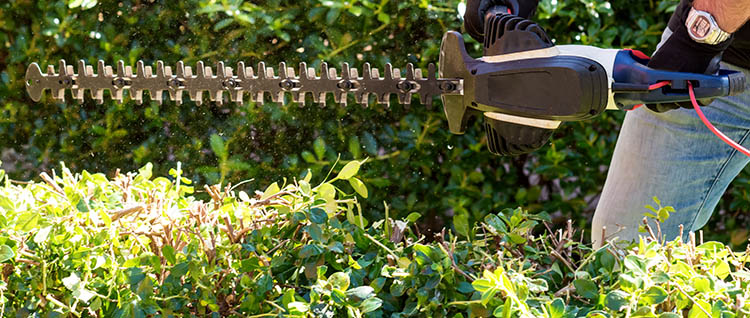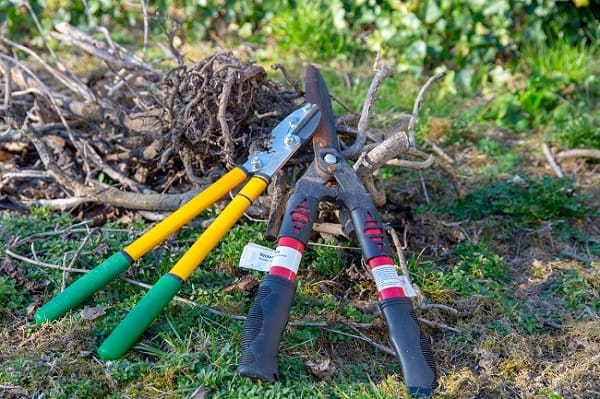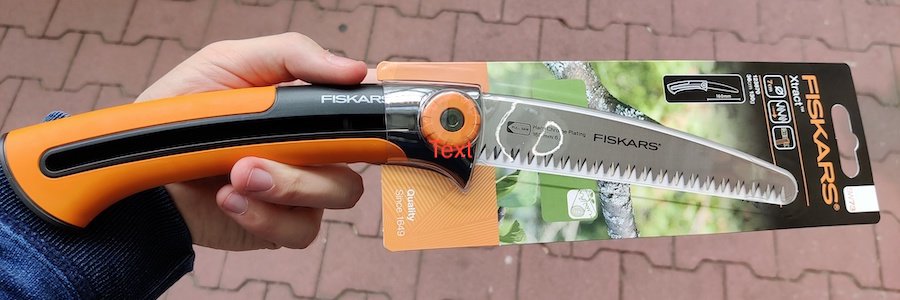If you’re asking this question, you may be looking for a shortcut when it comes to landscaping and yard work. But we all know that there are no shortcuts in life. Why would landscaping be any different?
Hedge trimmers cannot cut branches that are more than ¾” (2.54 cm) in diameter. Theoretically, hedge trimmers can cut some branches, but the further down you cut, the thicker the branches will become. At this point you should use garden or pruning shears, loppers, a pruning saw, or a chainsaw.
This article will explore hedge trimmers and their limitations along with providing information on some other tools that might be better for the job.
Branch Sizes and What To Cut Them With
There will come a point during your hedge trimming odyssey when you run into a branch thicker than what you’ve seen so far and think, “I wonder what would happen…,” or even, “I don’t want to go back to the garage and get another tool for this one branch.”
The truth is that there’s a physical limit to what your hedge trimmer can fit around, but that doesn’t necessarily mean it can cut it.
Hedge Trimmers Can Cut Up to ¾” (2.54 cm)
Most hedge trimmers have teeth spaced ¾” (2 cm) apart, and anything smaller than that should be no problem for that tool.
However, as we approach that limit, hedge trimmers will have trouble cutting them because to be able to shear the branch, there has to be some room for the blades to move back and forth.
If you put a ¾” (2.54 cm) branch into the ¾” (2.54 cm) gap between the teeth, there will be no room for them to slide across each other. This can dull the blade’s teeth, leave a ragged gash in a branch that will remain uncut, or worse, put undue stress on the motor and eventually burn it up.
Take a look at the table below for a better understanding of the appropriate tools for cutting varying branch sizes:
| Branch size | Appropriate tool |
| Twig | Hedge trimmer or garden shears |
| ¼” to ½” (0.6 to 1.3 cm) | Hedge trimmer or garden shears |
| ½” to 1” (1.3 to 2.5 cm) | Garden shears or pruning shears |
| 1” to 3” (2.5 to 7.6 cm) | Loppers |
| Larger than 3” (7.6 cm) | Chainsaw or manual pruning saw |
As with anything else, using the right tool for the job is one of the most important keys to trimming hedges safely and well.
I’ll cover in more detail these tools later in the article.
Hedge Trimmer Basics
The iconic hedge trimmer tool looks something like a sawfish– well, the saw part of the sawfish, anyway.
The blade is usually 20” (51 cm) long or longer, and that blade consists of two blades of the same size. Each has teeth extending to the left and right of the center of the blade.

One blade sits on top of the other, and the trimmer’s motor pushes one blade back and forth in a reciprocating motion. When a twig, leaf, or small branch gets between those teeth, it gets sheared off relatively cleanly.
Some people refer to garden shears and loppers as hedge trimmers, and either of those can trim hedges. For our purposes, though, we’ll be talking about the powered gardening tool described above.
Gas vs. Electric/Cordless
Hedge trimmers use one of two methods of power. A gas-powered hedge trimmer uses a two-stroke engine to move the blades, and these are generally the more powerful engines for landscaping tools.
That engine takes a precise blend of gasoline and two-stroke oil, and it’s got a choke, needs oil and maintenance, and runs rather loudly, but it will cut the heck out of some hedges.
Gas Hedge Trimmers
Two excellent gas hedge trimmers (available through Amazon.com) are Husqvarna’s 122HD60 Gas-Powered Hedge Trimmer, which sports a monster 23.7-inch (60 cm) blade, and the Poulan Pro PR2322 Gas-Powered Hedge Trimmer with its 22-inch (56 cm) blade.
Poulan has a great reputation, and it’s nearly impossible to be led astray by anything Husqvarna makes, so either of these would be a terrific choice.
Electric Hedge Trimmers
Electric motors are much quieter, but with less noise also comes less power.
Also, a corded hedge trimmer means you have to trail an extension cord around the yard, and there’s always the looming possibility of accidentally “trimming” your extension cord. At best, you’ve ruined your cord, and at worst, you get electrocuted.
It would be best if you avoided this.
You can find an excellent 22-inch (56 cm) corded trimmer in Black and Decker’s BEHT350FF Hedge Trimmer available through Amazon.com, and if you prefer a different brand, they’re certainly out there.
Just be sure you have a long extension cord because no matter how great your trimmers are, if you can’t reach the hedges without unplugging, they’re useless.
Cordless Electric Hedge Trimmers
Cordless electric hedge trimmers give you the freedom to move about without worrying about your extension cord. While the electric engines have gotten better over the years and battery technology has improved, those batteries still run out of juice.
And it should be noted that the heavier the job, the faster the batteries will deplete.
If you landscape for a living, or if you have vast amounts of hedges to trim, a cordless trimmer may be impractical for you.
That said, two outstanding cordless models are Dewalt’s DCHT820B Hedge Trimmer available through Amazon.com, with a 22-inch (56 cm) blade (and a battery compatible with all the pieces in Dewalt’s 20V line of cordless tools), and the 22-inch (56 cm) Ryobi’s 18-Volt Cordless Hedge Trimmer.
If you have a corded trimmer, you won’t have the power of a gas-powered unit, but you won’t run out of juice unless you didn’t pay your electric bill. And it will run much quieter.
Again, be careful not to cut into your extension cord.
Loppers and Shears

These are the manual-powered hedge trimmers.
While you don’t want to trim a privet row that runs the entire length of your back fence with a pair of either of these, they’re pretty helpful for hard-to-reach places and for any spot-trimming or clean-up you need to do.
Not that they can’t cut all day long, it’s just that there are much more efficient ways to go about your larger trimming tasks. We’ll look at more loppers and shears in a bit.
Hedge Trimming Basics
Almost without exception, when we trim hedges, we’re trimming them with a particular shape in mind. Perhaps you have the long row of shrubbery against the front of your house running under a bay window.
These we usually cut so that they’re squared-off and look like a green box from far away.
You may also have bushes that you want to be trimmed into a rounded shape, or you could be one of those advanced hedge people who use them for topiary, which involves complicated shapes and basically making a sculpture out of a living piece of shrubbery.

Of course, the people who created these elephants probably didn’t use hedge trimmers like we’re talking about, but we can see what’s possible when we trim hedges.
Work Slowly, Moving Back and Forth in Sequence
The key to trimming the bushes, shrubs, and hedges in your yard is to resign yourself to several passes.
This isn’t a one-step process.
If you haven’t trimmed in a while and want to take more than an inch (2.54 cm) or so off the top and sides, you can’t simply stick your trimmer down into the bush and start ripping. Well, you can, but you’ll get results your neighbors will consider less than ideal.
Instead, you’ll do much better by cutting a little at a time. Remember, you can always cut another half-inch off (1.3 cm), but only time will allow for it to grow back if you cut too much.
Perhaps more importantly, though, the further down you go into the hedges, the thicker the branches become.
There aren’t many BRANCHES at the top of your hedges unless they’re severely overgrown, and once you’re several inches down into it, there won’t be many twigs- and those are the things your hedge trimmers were made to cut.
For shapes (like sculpting a life-sized elephant or, more realistically, rounding off a shrub), you’ll have to rely on looks and just eyeball it. However, if you’ve got a long row and want to trim the top of it, the chances of you holding your trimmers level for the length of the row aren’t that great.
In this case, you’ll want to set up a guideline by tying a piece of string across the top at the level you want to trim down to.
Without a guideline, you risk cutting a significant slant into your hedgerow, or maybe an undulating wave across the top of it. I mean, if that’s what you’re going for, great, but it probably isn’t, so get the twine out before you start cutting.
Hedge Trimmer Alternatives for Bigger Branches
As mentioned above, at a certain thickness and above, a branch will start giving your trimmer some trouble.
If the branch is small enough to fit between the teeth of your hedge trimmer but thick enough so that the teeth can’t reciprocate, nothing will happen when you pull the trigger (except maybe your motor will overheat).
The teeth have to have enough space to get moving so that the engine can put enough power behind them to shear the branch off.
A dead branch will be easier to cut, sure, because it’s dried out, but even a dead branch can be too thick for the teeth of your hedge trimmers because, again, if the teeth can’t move, they can’t cut anything.
When to Switch Tools
So, you’re cutting along the top of your hedgerow that you want to be nice and even. You’ve done a few passes, but it’s still not low enough, so you make a few more passes, and eventually, you start running into thicker branches.
If you keep going, you’ll either leave a bunch of ragged cuts on those more significant limbs or have to stop pulling the branch from between the teeth because your trimmer jammed on them and try again.
Once you’ve reached the limit of your hedge trimmer’s ability to cut, it’s time to break out other tools.
Doing this sooner rather than later will result in less frustration on your part and will help keep your hedges healthy.
Start With Garden Shears
These are what most of us think of when we picture hedge trimmers that don’t have a motor. They usually have blades about 10 inches (25 cm) or longer, and the handles are about the same length.
They’re excellent for cutting through larger growths.
Basically a big set of scissors, these are what you’d trim your hedges with if you didn’t have access to an electric or gas-powered hedge trimmer.
They do the same job (although they can handle branches a little thicker than those a gas trimmer can cut), but your arms are the power source.
A set of shears like the Martha Stewart Long Handle Steel Garden Shears, available through Amazon.com, can get the job done but garden shears, in general, can be as unwieldy as powered hedge trimmers when you’re working in a tight space.

Either the blades won’t fit into a small area, or there’s no room for you to move the handles back and forth to cut.
In these cases, we need pruning shears.
Move Up to Pruning Shears
Think of pruning shears as scissors for the garden that aren’t enormous.
Fiskars make a great pair of shears- the 91095935J Steel Pruning Shears available through Amazon.com- that look like heavy-duty scissors and are specified for branches up to ⅝” (1.6 cm) thick.

Other makes accommodate different sizes, but they all work on the same principle- a handheld tool that allows you to snip off branches you either can’t cut with your trimmers or can’t reach with them.
Use Loppers for Thicker Branches
These are bigger, more aggressive versions of pruning shears.
They have the same scissors-like cutting mechanism as shears, but they can deal better with thicker branches, and their handles– usually more than two feet long– allow you to reach farther with them and, more importantly, apply more force to the blades when you’re cutting.
The 32-inch (81 cm) Husqvarna’s 599633302 Loppers available through Amazon.com are an ideal specimen.

Choose a Pruning Saw for Branches up to 6 Inches
A pruning saw is a hand saw with mean, jagged teeth, and these days, most are of the folding variety so that they operate much like a pocket knife.

The teeth of these saws are very sharp (I still have a scar on my hand from a pruning saw incident that happened during the Reagan administration), so it’s nice to be able to fold the blade away.
Anyway, these are recommended for cutting branches up to six inches (15 cm) in diameter.
You could conceivably cut a tree trunk with them, but it would just take forever.
Any thicker than six inches (15 cm) with one of these just makes more work for yourself. Corona offers its 10-inch (25 cm) RazorTOOTH Folding Pruning Saw available through Amazon.com, a solid option.
There’s also an adorable electric version of one of these that’s essentially a miniature chainsaw. Made by YXCYXG, admittedly not a household name, this 4-inch (10 cm), Mini Chainsaw Cordless Saws available through Amazon.com looks like an overbuilt set of pruning shears, and I must have one.
Use Chainsaw at the Base of the Hedge
The mack daddy of cutting things, a chainsaw is more for limbs than branches.
Loud and dangerous, and in constant need of bar oil, two-cycle gas, and a file for sharpening the blade, their inconvenience is more than offset by their power. Anyone who has ever felled a tree with a chainsaw immediately wanted to find something else to cut down.
If your hedges are ridiculously overgrown, you might make the first pass with a chainsaw. After that, you’ll only use this on larger branches toward the base of your hedges, and you’ll use it sparingly. A chainsaw is a cruel and unforgiving mistress, so be careful.
You cannot go wrong with a 14” (35.6 cm) Husqvarna 120 Gas Chainsaw available through Amazon.com, and while they’re available in longer (some are much longer) sizes, unless you’re regularly cutting down trees, this is all you need for your garden work.
Hedge Trimming Safety
If you’ve never used hedge trimmers before, it’s going to feel odd for the first little bit.
You’ve got a weirdly shaped tool in your hands, and it’s buzzing back and forth and cutting the crap out of everything in its path.
Take it slow, and again, don’t try to cut deep into the hedges. Start with cutting just a little off the top, then come back and cut a little more.
Once the trimmer feels good in your hands, you’ll be more comfortable, which is good and bad. If you get too relaxed with it, you can start to think you can go faster and cut deeper, but this is a mistake.
Going faster also opens you up to more likelihood of injury. Be careful with these or any power tool.
Take it slowly, and be methodical.
When you inevitably come across something your hedge trimmers can’t handle, stop and get the right tool. Trying to force your way through branches that are too thick will only cause problems ranging from an unattractive hedge to grave physical injury to yourself.
Sources
- Britannica: Topiary
- Discover Wildlife: Sawfish of the world
- Hunker: Can a Chain Saw Be Used to Trim Bushes?
- Iowa State University: Pruning Large, Overgrown Shrubs | Horticulture and Home Pest News
- One Hundred Dollars a Month: Cool Garden Topiary – Elephants, Flowers, Pigs, Peacock, Lion, Race Cars + More
- Pro Garden Tips: What Can Hedge Trimmers Be Used for?
- The Arches: Can you use a hedge trimmer to cut branches?
- TrimHedge: Will A Cut Hedge Grow Back?
- Worx.com: Hedge Trimming 101: How to Get Your Shrubs Spring-Ready
- Your Green Pal: The Ultimate Guide To Trimming your own bushes

